
There are likely multiple, potentially overlapping, causes of long COVID. Data sources are as follows: diabetes 9, cardiovascular outcomes 8, dysautonomia 12, 201, ME/CFS 10, 202 and breakthrough infections 4. The hazard ratio is the ratio of how often an event occurs in one group relative to another in this case people who have had COVID-19 compared with those who have not. Six months after breakthrough infection, increased risks were observed for cardiovascular conditions, coagulation and haematological conditions, death, fatigue, neurological conditions and pulmonary conditions in the same cohort. Additionally, there is clear increased risk of developing myalgic encephalomyelitis/chronic fatigue syndrome (ME/CFS) and dysautonomia. One year after the initial infection, severe acute respiratory syndrome coronavirus 2 (SARS-CoV-2) infections increased the risk of cardiac arrest, death, diabetes, heart failure, pulmonary embolism and stroke, as studied with use of US Department of Veterans Affairs databases.

There are currently no validated effective treatments.īecause diagnosis-specific data on large populations with long COVID are sparse, outcomes from general infections are included and a large proportion of medical conditions are expected to result from long COVID, although the precise proportion cannot be determined. With significant proportions of individuals with long COVID unable to return to work 7, the scale of newly disabled individuals is contributing to labour shortages 15. Symptoms can last for years 13, and particularly in cases of new-onset ME/CFS and dysautonomia are expected to be lifelong 14. Long COVID encompasses multiple adverse outcomes, with common new-onset conditions including cardiovascular, thrombotic and cerebrovascular disease 8, type 2 diabetes 9, myalgic encephalomyelitis/chronic fatigue syndrome (ME/CFS) 10, 11 and dysautonomia, especially postural orthostatic tachycardia syndrome (POTS) 12 (Fig. Hundreds of biomedical findings have been documented, with many patients experiencing dozens of symptoms across multiple organ systems 7 (Fig. There are many research challenges, as outlined in this Review, and many open questions, particularly relating to pathophysiology, effective treatments and risk factors. Long COVID is associated with all ages and acute phase disease severities, with the highest percentage of diagnoses between the ages of 36 and 50 years, and most long COVID cases are in non-hospitalized patients with a mild acute illness 6, as this population represents the majority of overall COVID-19 cases. The incidence is estimated at 10–30% of non-hospitalized cases, 50–70% of hospitalized cases 2, 3 and 10–12% of vaccinated cases 4, 5. At least 65 million individuals around the world have long COVID, based on a conservative estimated incidence of 10% of infected people and more than 651 million documented COVID-19 cases worldwide 1 the number is likely much higher due to many undocumented cases. Long COVID (sometimes referred to as ‘post-acute sequelae of COVID-19’) is a multisystemic condition comprising often severe symptoms that follow a severe acute respiratory syndrome coronavirus 2 (SARS-CoV-2) infection. Additionally, to strengthen long COVID research, future studies must account for biases and SARS-CoV-2 testing issues, build on viral-onset research, be inclusive of marginalized populations and meaningfully engage patients throughout the research process. Although these key findings are critical to understanding long COVID, current diagnostic and treatment options are insufficient, and clinical trials must be prioritized that address leading hypotheses. In this Review, we explore the current literature and highlight key findings, the overlap with other conditions, the variable onset of symptoms, long COVID in children and the impact of vaccinations. Biomedical research has made substantial progress in identifying various pathophysiological changes and risk factors and in characterizing the illness further, similarities with other viral-onset illnesses such as myalgic encephalomyelitis/chronic fatigue syndrome and postural orthostatic tachycardia syndrome have laid the groundwork for research in the field. At least 65 million individuals worldwide are estimated to have long COVID, with cases increasing daily.


More than 200 symptoms have been identified with impacts on multiple organ systems. Long COVID is an often debilitating illness that occurs in at least 10% of severe acute respiratory syndrome coronavirus 2 (SARS-CoV-2) infections.


 0 kommentar(er)
0 kommentar(er)
